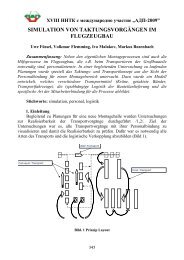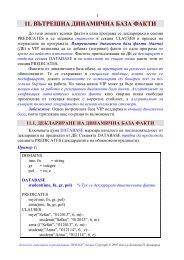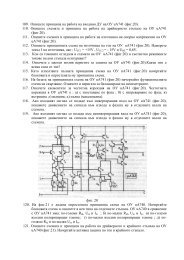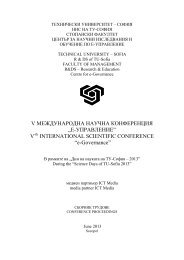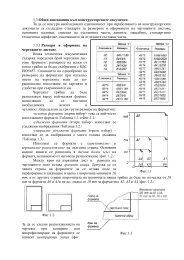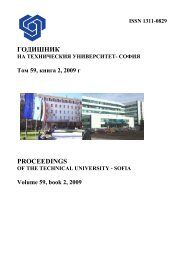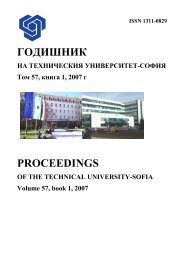Volume 61 Issue 2 (2011) - Годишник на ТУ - София - Технически ...
Volume 61 Issue 2 (2011) - Годишник на ТУ - София - Технически ...
Volume 61 Issue 2 (2011) - Годишник на ТУ - София - Технически ...
- No tags were found...
Create successful ePaper yourself
Turn your PDF publications into a flip-book with our unique Google optimized e-Paper software.
Over the past years, field and circuit coupling has been commonly used in time domainsimulations. There are two basic approaches to coupling the FEM with circuitequations. One is direct coupling where the field and circuit equations are coupled directlytogether and solved simultaneously. The other one is indirect coupling. In thiscase, the FEM and circuit simulator are treated as separate systems. They communicatewith each other by means of coupling coefficients. These coupling coefficientscan be lumped inductance matrices along with the back emf vector extracted fromfield solutions and computed winding currents from circuit simulation; or they can bewinding currents computed from field solutions and equivalent circuit parameters(impedances, circuit voltages) across winding terminal ports derived from circuit simulation.Another better choice for the coupling coefficient approach is to derivelumped inductance matrices and back emf vector from field solutions and equivalentcircuit parameters from the circuit simulation because this way of indirect coupling ismore accurate and stable. For direct coupling, the obvious advantages are reliableconvergence and computationally efficiency. Indirect coupling becomes attractivewhen there is a need to allow field simulators and circuit simulators to work independently,which makes the development of individual simulators more flexible andthe implementation of the coupling easier. [1-7]In this paper, a highly efficient approach for indirect coupling the FEM with externalelectric circuits is presented.A DC electromagnetic actuators with double E-shaped core is investigated as applicationexample to demonstrate the proposed methods. Electromagnetic actuator isfed by controllable power electronic current supply.2. Multiphisics Simulation EnvironmentMultiphisics field and electric circuit coupling is made with Finite Element MethodMagnetics (Femm) software package v4.2 [8], controlled by Octave/Lua interface andelectric circuit model is made in Matlab/Simulink environment. Block structure ofproposed model coupling is shown in Fig. 1.Finite element method is used to solve electromagnetic and thermal problem. TheFemm software package was employed. Computations were automated using Octave-Femm library.Fig.1. Block structure of proposed model coupling.114



